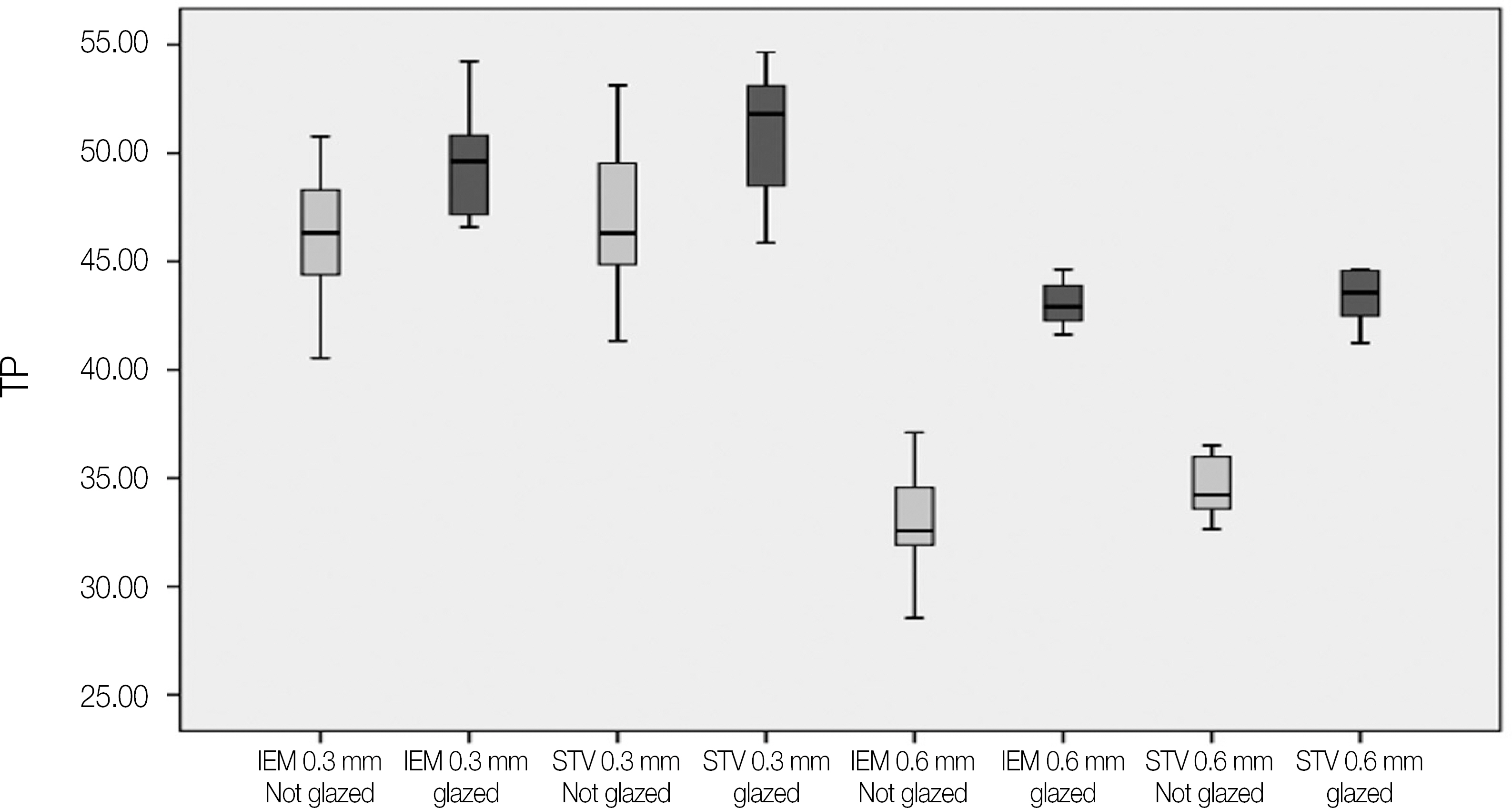J Korean Acad Prosthodont.
2015 Apr;53(2):138-143. 10.4047/jkap.2015.53.2.138.
Translucency of ceramic veneers on glazing effect
- Affiliations
-
- 1Department of Dentistry, School of Medicine, Jeju National University, Jeju, Republic of Korea. sehoon.kahm@gmail.com
- KMID: 2195396
- DOI: http://doi.org/10.4047/jkap.2015.53.2.138
Abstract
- PURPOSE
The aim of this study was to compare the translucency of two different laminate ceramic veneers with and without glazing.
MATERIALS AND METHODS
Ten millimeter side square-shaped specimens in 0.3 mm and 0.6 mm thick were fabricated for the following materials with and without glazing (n=80): A1 shade IPS e.maxPress (IEM) and Styleveneers (STV). The color coordinates (CIE L* a* b*) of the specimens were measured with a colorimeter. The Translucency parameter (TP) was calculated from the color difference of the material on a black versus a white background. For comparisons between materials and between the' not glazed'and' glazed'groups, unpaired t-test was used to analyze the data (P=.05).
RESULTS
The TP (Mean +/- SD) of' not-glazed'and' glazed'group of IEM specimens at 0.3 mm thickness were 45.99 +/- 3.00 and 49.53 +/- 2.28 and the TP at 0.6 mm thickness were 32.82 +/- 2.59 and 43.02+/-0.98, respectively. Likewise, the TP of' not-glazed'and' glazed'group of STV specimens at 0.3 mm thickness were 47.03 +/- 3.65 and 50.95 +/- 3.05 and the TP at 0.6 mm thickness group were 34.48 +/- 1.28 and 43.39 +/- 1.20, respectively. As the glazing of ceramic veneer differed, the TP of each ceramic veneer showed statistically significant difference. But, the result between the products was not statistically different.
CONCLUSION
Within the limitations of this study, we are concluded that the glazing process changed translucency of laminate ceramic veneers and the TP would not be affected by products.
Keyword
Figure
Cited by 1 articles
-
Color changes of ceramic veneers following glazing with respect to their composition
Sung-Joon Kim, Jae-Man Woo, Chan Woo Jo, Ju-Hee Park, Soo Kyung Kim, Se Hoon Kahm
J Adv Prosthodont. 2019;11(1):16-22. doi: 10.4047/jap.2019.11.1.16.
Reference
-
1. Joiner A. Tooth colour: a review of the literature. J Dent. 2004; 32:3–12.
Article2. Yilmaz K, Gonuldas F, Ozturk C. The effect of repeated firings on the color change of dental ceramics using different glazing methods. J Adv Prosthodont. 2014; 6:427–33.
Article3. Barizon KT, Bergeron C, Vargas MA, Qian F, Cobb DS, Gratton DG, Geraldeli S. Ceramic materials for porcelain veneers: part II. Effect of material, shade, and thickness on translucency. J Prosthet Dent. 2014; 112:864–70.
Article4. Yilmaz C, Korkmaz T, Demirkö prü lü H, Ergü n G, Ozkan Y. Color stability of glazed and polished dental porcelains. J Prosthodont. 2008; 17:20–4.5. Wiskott HWA. Fixed prosthodontics: principles and clinics. London: Quintessence publishing Co. Ltd;2011. p. 670–1.6. Choi BB, Woo YH. Contemporary fixed prosthodontics. 3rd ed.Seoul: Jisung;2003. p. 645.7. Chu FC, Chow TW, Chai J. Contrast ratios and masking abili-ty of three types of ceramic veneers. J Prosthet Dent. 2007; 98:359–64.
Article8. Baek KW, Kim SJ. Thickness and translucency of opaque shade composite resin for masking effect. J Korean Dent Assoc. 2011; 49:203–10.9. Sinmazisik G, Demirbas B, Tarcin B. Influence of dentin and core porcelain thickness on the color of fully sintered zirconia ceramic restorations. J Prosthet Dent. 2014; 111:142–9.
Article10. Heffernan MJ, Aquilino SA, Diaz-Arnold AM, Haselton DR, Stanford CM, Vargas MA. Relative translucency of six all-ceramic systems. Part II: core and veneer materials. J Prosthet Dent. 2002; 88:10–5.
Article11. Spear F, Holloway J. Which all-ceramic system is optimal for anterior esthetics? J Am Dent Assoc. 2008; 139:19S–24S.
Article12. Obregon A, Goodkind RJ, Schwabacher WB. Effects of opaque and porcelain surface texture on the color of ceramometal restorations. J Prosthet Dent. 1981; 46:330–40.
Article13. British standard specification for dental porcelains for jacket crowns. BS5612. London: British Standard Institution;1978.14. Johnston WM, Ma T, Kienle BH. Translucency parameter of colorants for maxillofacial prostheses. Int J Prosthodont. 1995; 8:79–86.15. Ryu SY, Lim JH, Cho IH. A study on the color stability of porcelain for porcelain fused to metal crown. J Korean Acad Prosthodont. 2000; 38:73–84.16. Chung IS, Lee DC. Effect of surface treatments and glazing temperatures on bond strength and color reproducibility in titanium-ceramic prosthesis. J Korea Content Assoc. 2010; 10:243–50.
Article17. Kelly JR. Dental ceramics: what is this stuff anyway? J Am Dent Assoc. 2008; 139:4S–7S.18. Etman MK. Confocal examination of subsurface cracking in ceramic materials. J Prosthodont. 2009; 18:550–9.
Article19. Guazzato M, Albakry M, Ringer SP, Swain MV. Strength, fracture toughness and microstructure of a selection of all-ceramic materials. Part I. Pressable and alumina glass-infiltrated ceramics. Dent Mater. 2004; 20:441–8.
Article20. Cattell MJ, Knowles JC, Clarke RL, Lynch E. The biaxial flexural strength of two pressable ceramic systems. J Dent. 1999; 27:183–96.
Article21. Rugh EH, Johnston WM, Hesse NS. The relationship between elastomer opacity, colorimeter beam size, and measured colorimetric response. Int J Prosthodont. 1991; 4:569–76.22. Turgut S, Bagis B, Ayaz EA, Korkmaz FM, Ulusoy KU, Bagis YH. How will surface treatments affect the translucency of porcelain laminate veneers? J Adv Prosthodont. 2014; 6:8–13.
Article
- Full Text Links
- Actions
-
Cited
- CITED
-
- Close
- Share
- Similar articles
-
- Color changes of ceramic veneers following glazing with respect to their composition
- How will surface treatments affect the translucency of porcelain laminate veneers?
- Comparison of the translucency of shaded zirconia all-ceramic systems
- Effects of staining liquids and finishing methods on translucency of a hybrid ceramic material having two different translucency levels
- Evaluation of marginal discrepancy of pressable ceramic veneer fabricated using CAD/CAM system: Additive and subtractive manufacturing


